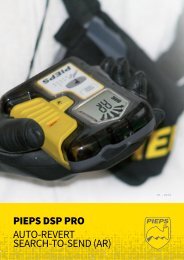LVS HintergrundwiSSen - pieps
LVS HintergrundwiSSen - pieps
LVS HintergrundwiSSen - pieps
Sie wollen auch ein ePaper? Erhöhen Sie die Reichweite Ihrer Titel.
YUMPU macht aus Druck-PDFs automatisch weboptimierte ePaper, die Google liebt.
Impact of advanced (electroniC)<br />
technologies used in<br />
avalanche probes<br />
Markus Eck,<br />
Gregor Krenn<br />
Michael Schober<br />
PIEPS GmbH<br />
Austria<br />
ABSTRACT: While the necessary time for beacons search had been the major focus of beacons manufacturers<br />
and has been reduced to almost a minimum, the time needed for direct recovering (shovelling and excavating)<br />
can’t be affected significantly. It simply depends on factors like burial depth, consistency of the snow,<br />
the adequacy of the used shovel, the right shovelling technique and finally by the physical constitution of the<br />
rescuer. In the past, one factor of the overall time, the PROBING, hasn’t been paid much attention for. While<br />
manufacturers did improve avalanche probes in general with the major focus on lightness and quality of the<br />
probe tubes and locking systems, the principle together with the educated technique of probing hasn’t been<br />
touched systematically. A newly introduced probe using additional electronic technologies claims to have a<br />
significant impact to the overall rescue time for avalanche victims. This study analyses this impact based on<br />
a large number of field tests.<br />
KEYWORDS: pinpointing, probing, shovelling, avalanche transceiver, companion rescue, ART<br />
1. INTRODUCTION<br />
In general, ongoing development and improvement of avalanche transceivers had a significant impact in the overall<br />
rescue time. Many important analyses and studies have been published about this issue. Most of them have been<br />
based on using classic avalanche safety gear (transceiver, probe, shovel). Therefore studies of Frank Tschirky (SLF;<br />
2000) and Dominique Stumpert (France; 2002) draw a good picture about the reasonableness of different rescue<br />
equipment and methods.<br />
This study takes a close look to the impact of “pinpointing and probing” within the total time of rescue and excavation<br />
of totally buried avalanche victims.<br />
2. BACKGROUND<br />
In open terrain - off the secured slopes - every individual<br />
is faced with the danger of slab avalanches.<br />
In the case of such an emergency a totally buried<br />
victim without an air pocket (primary assumed in<br />
rescue operations) has a respectable chance to survive<br />
within the first 10 up to max. 15 minutes (Figure<br />
right).<br />
Within this short period no organized rescue team<br />
can be up there and the companion rescue is the<br />
only chance for the buried victim.<br />
Figure 1: Chance of survival for persons who have been caught<br />
and completely buried in an avalanche in open terrain (Switzerland<br />
1981-1998, n=735) as a function of burial time in minutes.<br />
Authors: Hermann Brugger, Markus Falk<br />
Autoren & Adressen<br />
Corresponding author address: Markus Eck, Pieps GmbH, Austria; Tel: +43 3182 52556-14; fax: +43 3182 52556-19; email: eck.markus@<strong>pieps</strong>.com<br />
20<br />
PREMIUM ALPINE PERFORMANCE





